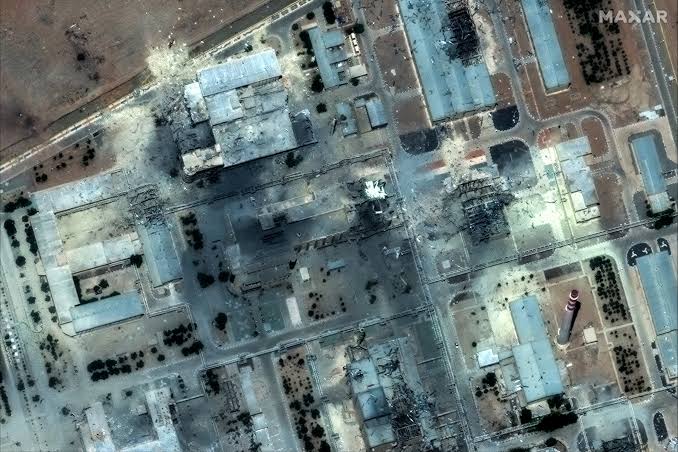INTRODUCTION: A WAR’S TURNING POINT
In the early hours of June 22, 2025, the United States launched Operation Midnight Hammer, a surprise, multi-pronged strike against Iran’s most fortified nuclear sites — including Fordow, Natanz, and Isfahan. The attacks, authorized by former President Donald Trump, marked a new chapter in the already volatile Iran–Israel–U.S. conflict, escalating the crisis into full-blown regional confrontation with global consequences.
As fallout spreads across Iraq, Israel, and the Middle East, and as U.S. cities enter high alert status, the world is asking: Are we on the brink of a new war?
Let’s explore the operation, global reaction, and what lies ahead.
OPERATION MIDNIGHT HAMMER: WHAT HAPPENED?
Strike Overview
Start time: 2:17 a.m. Tehran time, June 22
Assets used:
- 7 B-2 Spirit stealth bombers
- 1 Ohio-class submarine launched 26 Tomahawk Land Attack Missiles (TLAMs)
- GBU-57 "Massive Ordnance Penetrator" (MOP) bombs used on Fordow site
Targets hit:
- Fordow: Iran’s most secretive uranium enrichment facility, buried deep in a mountain near Qom.
- Natanz: Iran’s primary enrichment complex.
- Isfahan: Known for uranium conversion and centrifuge production
Pentagon General Dan Caine called it “the most complex non-nuclear military strike ever attempted against subterranean targets.
WHY STRIKE FORDOW?
Fordow was chosen as the lead target due to its advanced enrichment capabilities and hardened construction. It’s buried over 260 feet underground, requiring the use of specialized bunker-busting MOP bombs.
According to satellite images by Maxar Technologies, large-scale damage is visible at air vents and structural access points.

Pentagon press briefings suggest the core facility is likely “non-functional for the foreseeable future.”
🇮🇷 IRAN'S RESPONSE: “A BLOW THAT WILL BE RETURNED”
Iranian officials, speaking on state TV (IRIB), confirmed the attacks and promised “a proportional and painful response.” Foreign Ministry spokesperson Seyed Abbas Araghchi declared:
This was not a preemptive defense. This was a war crime.
DOMESTIC FALLOUT IN THE U.S.: HIGH ALERT
Following the strikes, the Department of Homeland Security raised the national threat level. U.S. cities including New York City, Washington, D.C., Los Angeles, and Oklahoma City were placed on Code Orange alert — citing threats from Iranian proxies or cyber retaliation.
Senator Markwayne Mullin (R-OK) called for emergency protection of U.S. nuclear power plants, as fears rise over sabotage or drone strikes.
RUSSIA RESPONDS: "AN ACT OF AGGRESSION"
The Russian Foreign Ministry strongly condemned the operation. In a fiery statement, President Vladimir Putin accused the U.S. of trying to ignite “another Iraq-style catastrophe” in the Middle East:
Washington seeks regime change in Iran through war, as it did in Baghdad. The world must not accept this.
Russia requested an emergency session at the UN Security Council. UN Secretary-General António Guterres warned of “a catastrophic miscalculation” and urged all parties to return to diplomacy.
DONALD TRUMP: “IRAN HAD BEEN WARNED”
In a televised address carried by Fox News, Donald Trump defended the strike:
Iran was playing with fire. They enriched uranium beyond limits. They hid their sites. We obliterated them. We warned them. They chose escalation.
At a press conference streamed live via ABC.com, Trump insisted this was not an attempt at full-scale war but a "necessary deterrent."
---
## 🗺️ WHERE ARE IRAN'S NUCLEAR SITES?
A quick look at Iran’s nuclear facilities:
| Facility | Function | Status |
| --------------------------- | -------------------------- | ------------------ |
| Fordow | Enrichment (high-security) | Severely damaged |
| Natanz | Enrichment hub | Partially disabled |
| Isfahan | Uranium conversion | Moderate damage |
| Arak | Heavy water reactor | Untouched |
| Tehran Research Reactor | Medical isotopes | Operational |
CAN IRAN ATTACK THE U.S.?
Yes — but indirectly. Iran’s military lacks the conventional capability to strike the U.S. mainland, but analysts expect:
- Proxy strikes via Hezbollah, Houthis, or militias in Iraq and Syria.
- Cyber attacks on infrastructure, power grids, financial systems.
- Potential assaults on U.S. military bases in the Middle East.
Pentagon spokesperson General Cain warned, "We anticipate asymmetrical retaliation — cyber, terror, regional destabilization."
IS DIPLOMACY DEAD?
Not yet, but it’s gasping.
- European allies (Germany, France) condemned the U.S. strike as “unilateral”.
- The Atlantic reports secret backchannels between Turkey, Qatar, and U.S. diplomats trying to prevent escalation.
- Iran's Middle East allies, including parts of Iraq’s Shi’a militias, are threatening to break ties with U.S. proxies
Former Vice President Mike Pence called for a "global anti-nuclear coalition to isolate Iran," while Nancy Pelosi demanded an emergency congressional inquiry into the legality of Trump’s order.
ANALYSIS: IS THERE GOING TO BE A WAR?
Short answer: Yes, if diplomacy fails within the next 30 days.
Long answer: This isn’t the Iraq War, but it could become one — with more nuclear risk.
- Iran now sees nuclear armament as survival.
- Israel will not tolerate resurgence of Iran’s program.
- U.S. domestic divisions make sustained military involvement unstable.
- Global alliances are fractured, and Iran’s regional partners are agitated
FINAL THOUGHTS
The U.S. bombing of Iran under Operation Midnight Hammer marks a dangerous inflection point in modern geopolitics. With cities on alert, Russia warning of broader war, and Iran vowing retaliation, we are entering a new era of nuclear brinkmanship.
Whether this was a decisive strike to neutralize a long-standing threat or an ignition point for regional war remains to be seen. The next moves — by Iran, Israel, and Washington — will determine whether 2025 becomes a year of containment or catastrophe.

You must be logged in to post a comment.